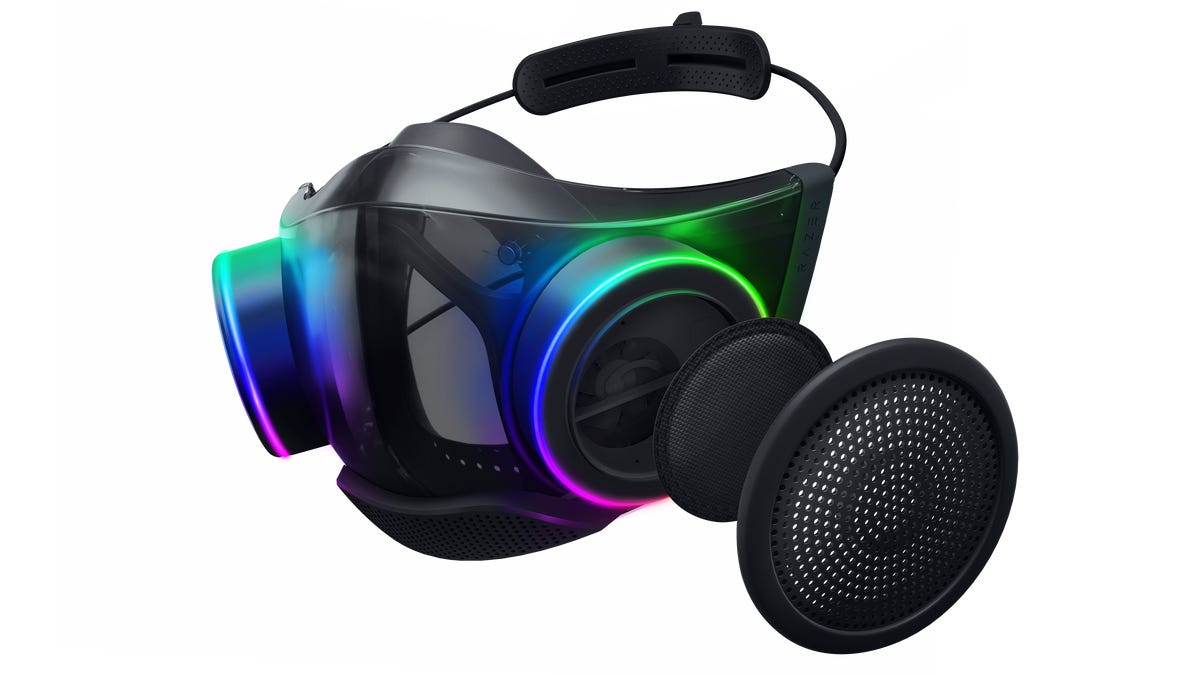 Why You Can Trust CNET
Why You Can Trust CNET Razer's $100 Zephyr N95 mask, nee Project Hazel, is ready for face time
The company has dropped some of the higher-end features of the popular concept version to hit the right price, though.

We've known since E3 that Razer was planning to ship its Project Hazel N95 mask, a concept design that debuted to much enthusiasm earlier this year at CES, this month, but didn't have many details about what the final product would be called, which features it would keep or how much it would cost. The concept has evolved into the Razer Zephyr, a $99 mask that's designed to be more comfortable for long-term wear with cooling two-way fans, transparent so people can see your mouth, uses replaceable filters to avoid the waste of disposable masks and of course, look cool with RGB lighting. Because: Razer.
Available now on Razer's site, the Zephyr ships with three pairs of filters tested to last about three days each for a full day's use; a pack with 10 sets of replacement filters will run $30. You can also buy it in a starter pack with the mask and 33 sets of filters -- roughly 3 months worth -- for $150.
The Zephyr loosely meets the FDA's definition of an N95 respirator, with silicone sealing around the edges, and Razer says it complies with mask mandates in the US and UK. But it also makes no health claims: "The Razer Zephyr is not a medical device, respirator, surgical mask or personal protective equipment (PPE) and is not meant to be used in medical or clinical settings. It is not tested specifically against the COVID-19 virus but offers the same functionality and adequate protection due to its 99% BFE rating."
It still has RGB lighting around the outside of the filter pods inside to show your mouth, but to hit the sub-$100 price, Razer had to jettison a couple of key features that were in the concept model: the UV charging case and voice amplification module.
Ditching the latter made it lighter and extended battery life -- it weighs 7 ounces (209 grams) and is rated for up to 8 hours with the dual-speed fans set to low. But one of the attractions of the concept was its ability to make your voice sound more natural using the amp, and now there's the extra complication of fan noise. The fans both intake air from the outside and expel it out of the mask, running it through the N95 filters in both directions. The filters look like they pop in easily underneath the magnetically attached covers.
The low speed runs at 4,200 rpm and the high at 6,200 rpm. You can turn them off as well to further conserve battery life, but by design it's not very breathable material and is completely sealed around your face, so it's bound to get pretty hot in there without running them. After a New York City summer with masks, I'd gladly welcome the fans. But I don't talk to people a lot. Razer doesn't rule out a future model with one, though.
It ships with an antifog spray to keep the transparent section transparent, but because of it, Razer recommends that you don't wipe the surface. But without the UV case (you charge it via plain old USB-C), how do you sterilize the inside? It may come with better cleaning instructions, but for the moment I'm stuck at "yuck."
Does the silicone catch in her hair?
Two adjustable straps that go around the back of your head and neck save your ears, and Razer claims they make the device one-size-fits all. They have silicone on the part that secures it on the back of your head, which looks like a potential drawback for folks like me; in some of its photos, the woman looks like she has the straps going under her long hair, but I can't figure out how that would work. Anyone who's used silicone ponytail elastics knows how, at best, it pulls uncomfortably on your hair, and pulls it out at worst. I also wonder how well glasses sit atop the nose section, though at least you probably don't have to worry about fogging them up like you do with many masks.
Answers to these burning questions and more await me when I finally get my unit to test. Stay tuned.

